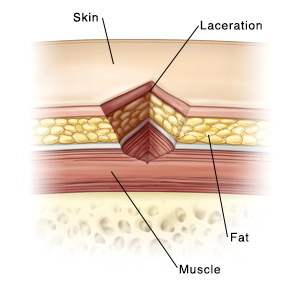Laceration, All Closures
A laceration is a cut through the skin. This will usually need stitches or staples if it's deep. Minor cuts may be treated with a surgical tape closure or skin glue.

Home care
-
Your healthcare provider may prescribe an antibiotic. This is to help prevent infection. Follow all instructions for taking this medicine. Take the medicine every day until it's gone, or you are told to stop. You should not have any left over.
-
The provider may prescribe medicines for pain. If no pain medicines were prescribed, you can use over-the-counter pain medicines. Follow instructions for taking any pain medicines. Talk with your provider before using these medicines if you have chronic liver or kidney disease, or ever had a stomach ulcer or digestive bleeding.
-
Follow the provider’s instructions on how to care for the cut.
-
Keep the wound clean and dry. Don't get the wound wet until you are told it's OK to do so. If the area gets wet, gently pat it dry with a clean cloth. Replace the wet bandage with a dry one.
-
If a bandage was applied and it becomes wet or dirty, replace it. Otherwise, leave it in place for the first 24 hours.
-
Caring for stitches or staples: Once you no longer need to keep them dry, clean the wound daily. First remove the bandage. Then wash the area gently with soap and clean running water, or as directed by the provider. Use a wet cotton swab to loosen and remove any blood or crust that forms. After cleaning, apply a thin layer of antibiotic ointment if advised. Then put on a new bandage unless you are told not to.
-
Caring for skin glue: Don’t apply liquid, ointment, or cream on the wound while the glue is in place. Don't do activities that cause heavy sweating. Protect the wound from sunlight. Don't scratch, rub, or pick at the adhesive film. Don't place tape directly over the film. The glue should peel off naturally in 5 to 10 days.
-
Caring for surgical tape: Keep the area dry. If it gets wet, blot it dry with a clean towel. Surgical tape often falls off in 7 to 10 days. If it has not fallen off after 10 days, you can take it off yourself. Put mineral oil or petroleum jelly on a cotton ball and gently rub the tape until it's removed.
-
Once you can get the wound wet, you may shower as normal. Don't soak the wound in water (no tub baths or swimming).
-
Even with correct treatment, a wound infection may sometimes occur. Check the wound daily for signs of infection listed below.
Scalp wounds
Follow your healthcare provider's specific instructions on showering. During the first 2 days, you may carefully rinse your hair in the shower to remove blood, glass, or dirt particles. After 2 days, you may shower and shampoo your hair normally. Don't soak your scalp in the tub or go swimming until the stitches or staples have been removed. Talk with your healthcare provider before applying any antibiotic ointment to the wound.
Mouth wounds
Eat soft foods to reduce pain. If the cut is inside your mouth, clean by rinsing after each meal and at bedtime with a mixture of equal parts water and hydrogen peroxide (don't swallow!). Or you can use a cotton swab to directly apply hydrogen peroxide onto the cut. You may also be prescribed a chlorhexidine solution to rinse with. Mouth wounds can be painful when eating. You may use an over-the-counter local numbing solution for pain relief. If this isn't available, you may use any numbing solution intended for teething babies. You may apply this directly to the sores with a cotton-tip swab or with your clean finger.
Follow-up care
Follow up with your healthcare provider as advised. Ask your provider how long stitches should be left in place. Be sure to return for stitch removal as directed. If dissolving stitches were used in the mouth, these should fall out or dissolve without the need for removal. If tape closures were used, remove them yourself when your provider advises if they haven't fallen off on their own. If skin glue was used, the film will wear off by itself. Generally, you should keep healing wounds out of direct sunlight for the first couple of months to try to lessen scarring.
When to get medical advice
Call your healthcare provider right away if any of these occur:
-
Signs of infection, including increasing pain in the wound, increasing wound redness or swelling, or pus or bad odor coming from the wound
-
Fever of 100.4°F (38.ºC) or higher, or as advised by your provider
-
Chills
-
Stitches or staples come apart or fall out, or surgical tape falls off before 7 days and the wound appears to be reopening
-
Wound edges reopen
-
Wound changes colors
-
Numbness around the wound after any numbing medicine should have worn off
-
Decreased movement around the injured area
Call 911
Call 911 if you can't control the wound bleeding with direct pressure.
Online Medical Reviewer:
Eric Perez MD
Online Medical Reviewer:
Raymond Turley Jr PA-C
Online Medical Reviewer:
Tara Novick BSN MSN
Date Last Reviewed:
5/1/2022
© 2000-2024 The StayWell Company, LLC. All rights reserved. This information is not intended as a substitute for professional medical care. Always follow your healthcare professional's instructions.